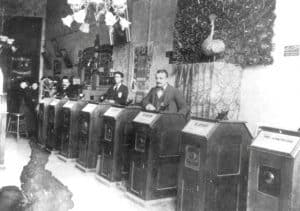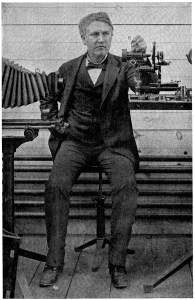Mechanical Eye: Early History Motion Pictures
By Alice Askins, Education Coordinator at Rose Hill Mansion
Starting in the 1890s, the Geneva newspapers talk about the astonishing new technology of motion pictures. The first article I found is from the Advertiser, June 9, 1891:
Thomas Edison
From the laboratory of the Wizard of Menlo Park [Thomas Edison] there is coming an invention which out-Edisons Edison. It is the marriage of the phonograph with the camera . . . The new wonder will be called the “Kinetograph” . . . strange sounding to the ear to-day, but destined perhaps soon to become as familiar as locomotive or telephone . . . [as] Mr. Edison . . . knows that its base principle is right all that remains to be done is to perfect the details . . . the machine is, in fact, merely a mechanical eye.
In fact, the Wizard discovered that perfecting the details would take longer than he had anticipated, and many other inventors were working on the moving picture idea in the US and elsewhere.
Edison went ahead and produced the kinetoscope, a silent moving picture device, while he and his lab continued to work, off and on, on a way to combine images with sound. A kinetoscope was not a movie projector – it was a private show for one person at a time, looking through a peephole. The image was produced by a strip of film bearing sequential images over a light source, with a high-speed shutter. In the spring of 1892, the lab began to make a nickel coin slot part of the kinetoscope. It received its patent in March 1893. Edison first demonstrated the kinetoscope in public in May, and it became popular in the United States and in Europe.
The first kinetoscope parlor opened in New York City in April 1894 and became the first commercial motion picture house. It had ten machines, each showing a different film. For a quarter, you could watch all the films in a five-machine row. The first ten films in the first program (made by Edison) featured a barbershop scene, blacksmiths, a contortionist, Highland dancing, wrestling, and so on. Each film was very brief (less than a minute), and watching five of them was comparatively expensive – for 25 cents you could get a ticket to a major vaudeville show. Still, the new technology was very popular and kinetoscope parlors proliferated.
It seems that Geneva did not have a kinetoscope parlor, but the devices did come to town. On April 19, 1895, the Daily Gazette reported:
Don’t fail to see Edison’s latest invention the kinetoscope. It will be on exhibition at Foster Bro’s bookstore, 24 Seneca St. . . . There are four scenes, each . . . an act such as a barber shop episode, shooting glass balls, a wrestling match, and London gaiety girls in skirt dancing, with lifelike fidelity. A nominal charge of 5 cts for a view through each kinetoscope.
Eleven days later, the Advertiser reported, “The four Kinetoscopes were packed up and removed from here last Wednesday. It is a wonderful thing, but the price is too high. A person can see all four of them in three minutes and it costs 20 cents.”
Early in the 1890s, many inventors thought that projecting films to a large audience was the way to go. Edison objected to this idea:
No, if we make this screen machine that you are asking for, it will spoil everything. We are making these peep show machines and selling a lot of them at a good profit. If we put out a screen machine there will be a use for maybe about ten of them in the whole United States. With that many screen machines you could show the pictures to everybody in the country—and then it would be done. Let’s not kill the goose that lays the golden egg. [Terry Ramsaye, A Million and One Nights: A History of the Motion Picture Through 1925. 1926, 1986. Quoted in Wikipedia.]

Kinetoscope Parlor in San Francisco, 1894-95
The tide, however, was running against Edison and the kinetoscope. The first, and most successful, projector was the cinematograph, invented by Leon Bouly of France in 1892. He sold it and the name to August and Louis Lumiere, and in 1895 they gave the name to a device that they had improved substantially. The cinematograph was both a motion picture camera and projector. In December 1895 the Lumieres organized the first commercial screening of a cinematographic film. They had produced ten short films, each running for about 50 seconds, including a sequence of their workers leaving the Lumiere factory. The cinematograph became popular worldwide, and was used in nickelodeons (inexpensive movie theaters), fairs, and vaudeville houses.
Projected motion pictures became increasingly popular in 1895, and the kinetoscope was losing business to the Mutoscope (a peepshow device that worked much like a flip book). Edison finally looked into a projection system. Charles Francis Jenkins and Thomas Armat had worked on Jenkins’s Phantoscope, which Jenkins had used for the first documented projection of a filmed movie in June 1894. The two inventors parted ways and the device eventually came to the Edison Company. Edison agreed to produce the Phantoscope and films for it, if it was advertised as a new Edison invention named the Vitascope.
The Daily Times mentioned the Phantoscope in 1895 – one in Atlanta was damaged in a fire (October 16.) The Vitascope showed up several times in the local papers in 1896. The Daily Gazette reprinted a description of the effect of one film:
When you throw the picture of an express train on a screen in such a realistic way that the persons who see it scramble to get out of its way . . . it’s about time to stop. That’s what the . . . new form of the vitascope . . . does. At first you seem to be looking straight away down a railroad track. Suddenly the Empire State Express looms in sight ‘way off in the distance, and comes steaming towards you – right dead at you at full speed. Two ladies who were in a box last night screamed and fainted. . . . this . . . is the most startling display ever thrown on a screen . . . A party of New York Central officials who were present were delighted . . . (December 18.)
The Brooklyn Daily Eagle printed a complaint in 1897, about the proliferation of motion picture machines:
The spell of “scopes” and “graphs” under which we have labored ever since the first modernized magic lantern began to squirt continuous pictures on a screen . . . continues unabated. With infinite pains I have undertaken to compile a list of the frantic diversity of freakish names that have been foisted upon us to designate these otherwise admirable contrivances. The list is, I fondly believe, a heartbreaker. Behold not alone the eidoloscope . . . but also the biograph, bioscope, verascope, vitagraph, cinematographe, cinematoscope, cinetoscope, cineograph, kinematograph, kinematoscope, kinetograph, kinetoscope, kineoptiscope, triograph, trioscope, centograph, zimograph, multiscope, hypnoscope, vitamotograph, magniscope, magiscope, animatograph, animatoscope, kineopticon, motograph, mutagraph, alethoscope, projectoscope, and last and most dreadful, phantographoscope. There may be others . . . (May 2.)
Many of these devices were mentioned locally, but by 1898 it seems that the particular projector was becoming less of a concern. On December 17, the Daily Times used the simple headline “Moving Pictures.” After 1900, it was more and more common for Genevans to see and read about moving pictures, life motion pictures, and motion pictures, without any reference to the projector. By 1907, Geneva had a theater – “A sort of Dreamland show will shortly open on Exchange street . . . Oh, we’re fast creeping up to a city of the first class!” (Advertiser-Gazette, January 10.) By 1913, we were calling them movies.

